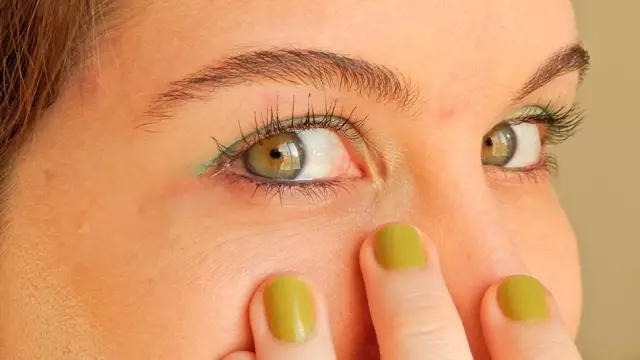- Author Rachel Wainwright [email protected].
- Public 2023-12-15 07:39.
- Last modified 2025-11-02 20:14.
Ptosis of the upper eyelid
General characteristics of the disease

Ptosis is an abnormal drooping of the upper eyelid. In this case, the patient partially or completely closes the palpebral fissure and, accordingly, the field of view. Therefore, ptosis is not only a cosmetic defect, but also a serious ophthalmic disease. Upper eyelid ptosis can lead to functional blindness.
Ptosis of the upper eyelid can be acquired or congenital. In children with a congenital form of the disease, ptosis is often combined with strabismus or amblyopia (lazy eye disease).
Treatment of ptosis is mainly surgical.
Causes of ptosis of the upper eyelid
Causes of ptosis include injury or birth defects that lead to muscle weakness or impaired neuromuscular transmission in the upper eyelid. Ptosis in young children can be caused by trauma during childbirth, neurofibroma (tumor of the nerve sheath in the upper eyelid), or hemangioma (tumor of the blood vessels).
Among the causes of ptosis of an asymmetric bilateral, slowly progressive form is called myasthenia gravis (an autoimmune neuromuscular disease). Dystrophic myasthenia gravis simultaneously causes poor facial expressions and wasting of the temporal muscles.
Ophthalmoparesis, as one of the possible causes of ptosis in both eyes, leads to a symmetrical form of the disease and weakness of the circular muscle of the eyes.
The causes of acute ptosis of the upper eyelid are usually neurogenic. The drooping of the eyelid is often observed with Horner's syndrome (pathology of sympathetic innervation). With this type of pathology, ptosis of the upper eyelid develops in only one eye.
The reason for ptosis of the senile form is age-related changes in the muscles of the eyelid and sagging skin, which has lost its elasticity, above the eye fissure.
Whatever the reasons for ptosis, patients need to consult an ophthalmologist.
Signs of ptosis of the upper eyelid
The main symptom of ptosis is drooping of the eyelid of one or both eyes. A patient with ptosis of the upper eyelid cannot completely close the eye, and this leads to visual fatigue and irritation of the eye tissues.
Patients with ptosis of the upper eyelid also find it difficult to blink. Trying to expand the field of vision, they throw their heads back. Attempting to lift the eyelid with your hands can lead to infection of the patient's eyes. Congenital ptosis in children often occurs against the background of strabismus, amblyopia or diplopia (double vision).
Diagnostics and treatment of ptosis of the upper eyelid
Diagnosis of ptosis is not difficult. To make a diagnosis, the eyelid height is measured, the symmetry and completeness of movement of the upper eyelids of both eyes are checked.
Treatment of ptosis of the upper eyelid is surgical. The standard operation for ptosis is shortening the eyelid by forming a so-called duplicate levator on it. For this, three U-shaped sutures are made on the eyelid of a patient in need of ptosis treatment.

This type of surgery for ptosis cannot be performed in patients with a congenital form of the disease, since in this case the patient, as a rule, has a too thin layer of muscle mass in the eyelid. Treatment of ptosis of the upper eyelid with the imposition of a duplicate of the levator often leads to the eruption of sutures and a relapse of the disease.
An alternative operation for ptosis of the upper eyelid is a technique for forming a duplicate tarzoorbital fascia. It differs from the above-mentioned method of treating ptosis by the method of strengthening the fold of the eyelid. In addition to three U-shaped sutures, this operation for ptosis involves the use of diathermocoagulation (moxibustion with diathermic current) of the upper eyelid muscle sheath.
The use of diathermocoagulation in the treatment of ptosis of the upper eyelid makes it possible to reduce the invasiveness of the operation, improve the subsequent scarring of the eyelid muscles, and do without the use of grafts during the surgical correction of pathology.
Surgical treatment for ptosis of the upper eyelid is performed under local anesthesia. The exception is children: during operations for ptosis in children, the use of general anesthesia is recommended.
YouTube video related to the article:
The information is generalized and provided for informational purposes only. At the first sign of illness, see your doctor. Self-medication is hazardous to health!






